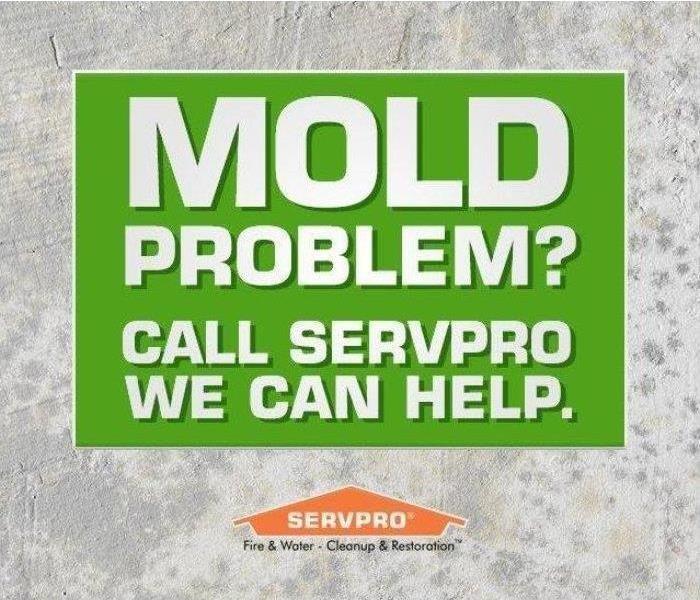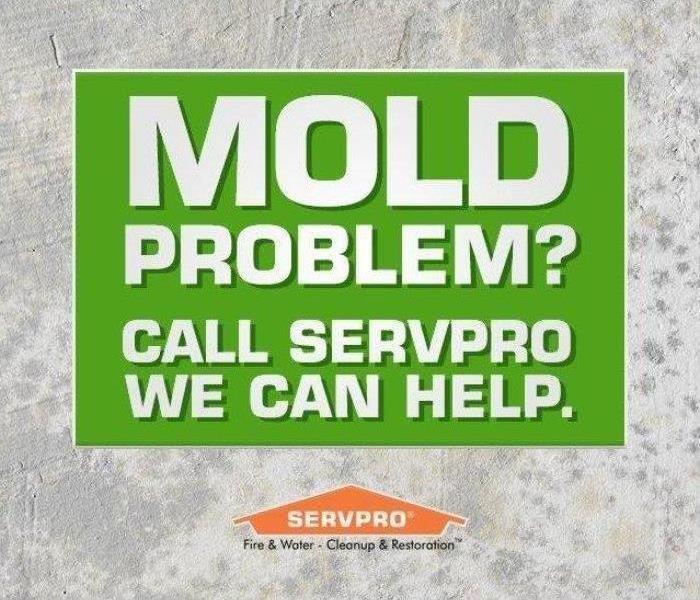Recent Mold Remediation Posts
Mold Remediation: Dangers in the Ducts
4/1/2019 (Permalink)
Mold remediation is a serious subject, covered at large by professionals and institutions that specialize on the subject matter. While I'm not a mold expert, I do know air duct cleaning and how important it is to complete an HVAC Duct Cleaning after any mold, mildew, or fire restoration. The HVAC system of a building, residential or commercial, is designed to convey the dirty undesirable air from the living space and replace it with clean, heated or cooled, conditioned air that is pleasant to breathe and comfortable to building occupants. Depending on the building type and room use, many building codes call for the air in a room to be exchanged five to 15 times per hour. For HVAC that are clean and have adequate filtration, every exchange of air generally means the indoor air quality is improving. However, when mold, mildew, soot, allergens, and other contaminants are present, in the HVAC system, the IAQ is reduced with every air exchange. Proper source removal HVAC air duct cleaning, following any restoration project, will reduce the contaminants within the HVAC system and in some cases completely remove the chances of recontamination. It sometimes is overlooked that while a building itself is being remediated, the HVAC system is still in operation and therefore moving mold spores, smoke particles, and other contaminants throughout the return and supply air duct, as well as other HVAC system components. Because the HVAC system is redistributing the air throughout the building, a small about of dirty/contaminated air has the potential to recreate the need for an entire restoration project in as little as a few days. Source removal, the practice of cleaning by removing contaminants the HVAC system, is the method prescribed within the NADCA (National Air Duct Cleaners Assocaiton) Standard, ACR-2013. Source removal can be achieved in a variety of ways, but is most often achieved by using a negative air vacuum/collector, rotating duct brushes, and compressed air whips/skippers to loosen debris from the duct walls allowing the airflow from the vacuum/collector to evacuate it from the HVAC system. The methods for a proper professional HVAC Air Duct Cleaning have been continually developed and refined for 30 years by working professionals engaged with NADCA and other IAQ associations.
Mold Stain Remover
12/3/2018 (Permalink)
Mold stain removal can be challenging, even after you have removed the mold itself. Unfinished areas of the home such as the basement and attic are often susceptible to mold stains, as these areas are not typically seen and the longer the mold lives, the longer the stains can penetrate the surface of the material. Wood decks and concrete are also susceptible to mold stains because they have porous surfaces that allow the mold stains to penetrate deep, making them harder to clean. Not all mold stains can be removed, but there are some steps you can take to reduce or eliminate staining.
What Causes Mold Stains?
To understand mold stains, it helps to understand the structure of mold. Mold is a fungus that grows in multi-cellular filaments called hyphae. These hyphae produce pigment, or color. Mold colors can range from white or gray to green, red, brown or black, and the darker the color, the more pigment it produces.
As these mold hyphae grow into the material of your home, be it wood, drywall, fabric or others, the pigment can transfer to that material. So, even if you kill or remove the mold, the pigment is left behind.
Are Mold Stains Dangerous?
Unlike the mold itself, any stains left behind after you have removed the mold are harmless. However, mold stains are an aesthetic problem and removing the mold stains is important for property value and improving the appearance of your home.
While you may choose to ignore mold stains in an unobtrusive area of your home like the basement or attic, you should never ignore the growth of mold. Mold can grow on most surfaces in your home including tile grout, wood, carpet, drywall/sheetrock, ceiling tile, painted surfaces, fabric and paper. Unchecked mold growth can cause damage by eroding the structural integrity of beams, trusses, walls, ceilings, floors and more.
In addition, mold growth is a sign that you have a water problem that needs to be addressed immediately. You must identify the source of the water, whether it is a leaky pipe, humid bathroom, broken appliance, septic tank backup or storm water infiltration, and perform the necessary repairs.
Mold growth is also dangerous because it is a known health hazard. Mold acts as an allergen, and if you breathe in mold spores you may experience sneezing, nasal and sinus congestion, asthma symptoms, itchy eyes and more. Over time, your symptoms may get worse or you may experience fungal infections or chronic rhinitis or asthma. Mold can cause more serious, long-term health problems in young children, the elderly and people with other health conditions or compromised immune systems.
Mold Stain Removal Guidelines
Mold stain removal depends upon the material where the staining has occurred. You can try using soap, vinegar and household cleaners to remove stains. For difficult to remove mold stains, we recommend Concrobian Mold Stain Eraser. It is bleach-free, so it won’t damage surfaces. It is safe to use on wood, stone, fiberglass, plastic, laminate, metal, aluminum and concrete.
Grout: Mold growth in grouts cannot be satisfactorily removed because it grows into the grout. If you try to clean it, it will quickly grow back. The grout has to be dugout and replaced with new grout.
Wood: Mold stain removal on wood such as flooring, decks, fences or wood trim may require a trip to the hardware store. But first, try cleaning with ingredients you probably have in your kitchen. To clean surface wood stains, mix vinegar, mild dish soap, and water. Dip a rag in the vinegar mixture and wipe the wood. Wipe again with another damp rag, and dry thoroughly. If the mold grows back in a week or two, that means it has penetrated the surface.
If the mold has penetrated the surface of the wood, you will need to sand it to remove it all. Sanding can be dangerous because it will release mold spores. Always wear an N-95 face mask when sanding moldy wood, and only sand wood that is located outdoors. Using #100-grit sandpaper, sand the wood in a circular motion wherever you see mold. Then follow up with #220-grit sandpaper. Use a HEPA-vacuum to clean up the dust after sanding. Now you can repaint or re-stain the wood. If you are unable to completely remove the mold because it has penetrated too deeply, you should replace the wood.
If the wood is located indoors, it is not safe to sand it yourself. The risk of inhaling or spreading mold spores is too great. For small amounts of mold on wood inside, clean as much as possible by scrubbing with a cleaner, allow the surface to dry, and then encapsulate any remaining mold with a commercial mold sealant, like Foster 40-50. If the mold covers more than 10 square feet, the U.S. Environmental Protection Agency (EPA) recommends hiring a professional removal company.
Walls and Ceilings: Walls and ceilings are usually porous, so if the mold has penetrated the material, it will need to be replaced. To clean surface mold from painted walls and ceilings, use a mold cleaner. Spray the affected area and scrub with a soft brush or rag to remove the mold. If staining still shows then the mold has penetrated the surface, and the material should be replaced.
Make sure that all of the mold has been removed before repainting. Otherwise, the mold will continue to grow and return.
Masonry Surfaces: Unpainted masonry surfaces, such as walls and ceilings, constructed of unpainted concrete cinder blocks, poured concrete, cement boards, clay blocks, ceramic tiles, plaster, marble, and granite, do not support mold growth. However, white salt deposits that migrate to the surface can have elevated levels of mold and bacteria. Also, if the masonry surface was painted, mold can grow on the paint. Remove the mold by spraying the surface with water, then use a wire brush or scraper to remove the salt deposits and loose paint. Allow it to dry, HEPA-vacuum, and then spray with a fungistatic disinfectant such as RMR-141. Any remaining stain can be removed using Concrobian Mold Stain Eraser.
Leather: Mold on the surface of leather can be cleaned using either mild soap or vinegar. If you choose to use soap, mix a solution of gentle detergent or saddle soap and water in a spray bottle. Spray the stained leather and wipe with a clean, dry cloth. Or you can spray vinegar and wipe it off, or wipe the leather with a cloth soaked in vinegar. In either case, don’t let the surface get or stay too wet, otherwise the moisture can permanently damage the leather. If mold has penetrated the surface, it will come back, and the leather will need to be discarded.
Clothing: Your success in removing mold stains from clothing can depend on the fabric and how long the stain has been sitting. For white cotton fabrics, wash with chlorine bleach according to the instructions that came with your washing machine or on the bleach bottle. For colored fabrics, use a wash booster like OxiClean or pretreat the stain with a stain lifter. It may be helpful to let the item soak in OxiClean before washing. For delicate fabrics, items that are not machine washable, or stains that don’t come out with the other suggested methods, you can try taking it to a dry cleaner. Be sure to point out the stain so they can treat it properly. If the mold cannot be removed, the clothing should be disposed of.
Mold Remediation
11/4/2018 (Permalink)
How to determine if I can handle the mold clean up in my house?
Do I need a professional mold remediation company?
Firstly, the source of the water intrusion needs to be resolved. If the source continues to allow water intrusion, the home will eventually return to an unhealthy condition.
You might want to consult a mold remediation company….
- If the visible mold spores affected area, from tip to tip, is larger than a 10 square foot area
- If you suspect that the heating ventilation system may be contaminated
- If the original water was from a black water source (sewage contamination)
- If you have health concerns of the occupants
There are numerous mold cleaning products on the market for consumer use. It is best not to use OVER USE any harsh chemicals. Simply scrub hard surfaces with a detergent and water, and let the area dry. It is very important to use personal protective equipment while cleaning: eyes, hands, and respiratory system. Upon completion of the cleaning, the area should be free of visible mold spores and musty, moldy odors (mold staining on structural materials may still be present). It is critical to monitor the affected area for a few months to make sure the area does not return to unhealthy. The area needs to continue to be dry, clean and odor free. If the area again begins to deteriorate, go back to correction of the source of water intrusion. It is possible that the original correction was not sufficient or there might a secondary source of water intrusion.
If you determine that your home or business has a mold problem, and the source of the moisture intrusion has been corrected, SERVPRO of Portage County can inspect and assess your property. If professional mold remediation is needed, we have the training, equipment, and expertise to handle the situation.
Vacant Homes and Mold Growth
11/3/2018 (Permalink)
Vacant homes or unattended homes have unique issues that can that increase the likelihood of mold growth. These homes are locked up without inhabitants coming or going, turning on the heat, running air exchangers or ventilation fans, and have restricted air flow. Thus moisture or condensation can build up inside and create an ideal climate for mold. To thrive mold needs moisture, oxygen, a food source and a surface on which to grow; easily available within a residence. Mold spores are abundant in our environment, and once a mold spore has attached itself to dust particles, which provides the nutrients needed, all the spore needs is moisture.
Procrastinate where mold cleaning is necessary can be a costly decision. If mold spores are allowed to proliferate, you may be faced with extensive structural damage to your home and possibly loss of property value. Today’s buyers are very leery about investing into a home with visible mold contamination. Additionally, consumers are very aware that some molds species can produce toxins and allergens.
The remediation priority would be to correct the excessive of moisture build up in the residence. Remediation would include 1) water proofing, 2) corrective measures to secure windows and doors, 3) create healthy air flow. etc. After the corrective measures to reduce the moisture, professional mold remediation of all affected structural materials, contents, and HVAC system would need to be completed. If the issues that are causing the elevated moisture are not corrected prior to remediation services, after a period of time, the home would again become unhealthy.
If you determine that your home or business has a mold problem, and the source of the moisture intrusion has been corrected, SERVPRO of Portage County can inspect and assess your property. If mold remediation is needed, we have the training, equipment, and expertise to handle the situation.
Evaluating Mold: Air Sample Testing
11/3/2018 (Permalink)
All buildings contain mold spores since they a natural part of the environment. An elevated mold count especially one that contains spores from varieties of mold that are commonly found when water damage is involved, such as stachybotrys chartarum, can indicate that there may be a structural moisture problem.
In the insurance claim process, mold testing in is generally utilized after the mold has been remediated to confirm that the mold spore count is at or below the count found outside the building. The test is conducted while the remediated area is contained in order to confirm the success of the cleaning process.
Determination of airborne spore counts is accomplished by way of an air sample, in which a specialized pump with a known flow rate is operated for a known period of time. Conducive to scientific methodology, air samples should be drawn from the affected area, a control area, and the exterior.
The air sampler pump draws in air and deposits microscopic airborne particles on a culture medium. The medium is cultured in a laboratory and the fungal genus and species are determined by visual microscopic observation. Laboratory results also quantify fungal growth by way of a spore count for comparison among samples. The pump operation time was recorded and when multiplied by the operation time results in a specific volume of air obtained. Although a small volume of air is actually analyzed, common laboratory reporting techniques extrapolate the spore count data to equate the amount of spores that would be present in a cubic meter of air.
If you have questions or need further information about the mold testing process, contact SERVPRO of Portage County at 800-648-1212.
STORM, FLOOD, AND HURRICANE RESPONSE
9/4/2018 (Permalink)
Recommendations for the Cleaning and Remediation of Flood-Contaminated HVAC Systems: A Guide for Building Owners and Managers
Introduction
During flooding, systems for heating, ventilating, and air conditioning (HVAC) can become submerged in flood waters. As a result, these systems may contain substantial amounts of dirt and debris and may also become contaminated with various types of microorganisms such as bacteria and fungi. The following recommendations will help ensure that HVAC systems contaminated with flood water are properly cleaned and remediated to provide healthy indoor environments.
Microorganisms may grow on all surfaces of HVAC system components that were submerged in flood waters. In addition, moisture can collect in HVAC system components that were not submerged (such as air supply ducts above the water line) and can promote the growth of microorganisms. Therefore, all components of the HVAC system that were contaminated with flood water or moisture should be thoroughly inspected, cleaned of dirt and debris, and disinfected by a qualified professional. The following recommendations will help ensure that HVAC systems contaminated with flood water are properly cleaned and remediated to provide healthy indoor environments.
These recommendations will be reassessed periodically and updated as appropriate.
Steps Before Cleaning and Remediation
- If the building is to remain partly occupied (for example, on upper floors not affected by flood waters), isolate the construction areas where HVAC systems will be cleaned and remediated by using temporary walls, plastic sheeting, or other vapor-retarding barriers. Maintain the construction areas under negative pressure (relative to adjacent non-construction areas) by using blowers equipped with HEPA filters (high-efficiency particulate air filters) to exhaust the area. To ensure complete isolation from the construction areas, it may be necessary to pressurize the adjacent non-construction areas and temporarily relocate the outdoor-air intake for the HVAC system serving the occupied areas.
- Take precautions to protect the health of workers who are cleaning and remediating the HVAC system. Make sure that workers wear at least an N-95 NIOSH-approved respirator to protect against airborne microorganisms. Increased levels of respiratory protection (for example, powered, air-purifying respirators equipped with high efficiency filters) may be appropriate depending on the level of visible contamination. In addition, when using chlorine bleach or other disinfectants in poorly ventilated environments, it may be necessary to use appropriate chemical cartridges in addition to the particulate filters to protect workers from breathing the chemical vapors. Employers must implement a complete respiratory protection program that meets the requirements of the OSHA respiratory protection standard (29 Code of Federal Regulations 1910.134). The minimum requirements for a respiratory protection program include a written standard operating procedure for the following: selecting and using respirators; the medical evaluation of workers to determine whether they are physically able to wear the respirator selected for use; training and instructions on respirator use; the cleaning, repair, and storage of respirators; the continued surveillance of work area conditions for worker exposure and stress; and a respirator fit-testing program. For tight-fitting respirators, fit-testing is necessary to help ensure that the respirator fits tightly, reducing the potential for leakage of outside air from around the edge of the mask. In addition, employers must provide workers with appropriate skin, eye, and hearing protection for the safe performance of their jobs.
HVAC Cleaning and Remediation
- Remove all flood-contaminated insulation surrounding and within HVAC system components. Discard these contaminated materials appropriately following applicable Federal, State, and local regulations.
- Remove contaminated HVAC filter media and discard appropriately following applicable Federal, State, and local regulations.
- After removing any insulation and filters, clean all flood-contaminated HVAC system component surfaces with a HEPA-filtered vacuum cleaner to remove dirt, debris, and microorganisms. Pay special attention to filter racks, drain pans, bends and horizontal sections of air ducts where debris can collect.
- After removing any insulation or debris, disinfect all HVAC system component surfaces while the HVAC system is not operating. Use a solution of 1 cup of household chlorine bleach in a gallon of water. Do not mix bleach with other cleaning products that contain ammonia.
- Conduct the cleaning and disinfection activities in a clean-to-dirty work progression. Consider the use of auxiliary fans to supply “clean” air to the worker position and carry aerosolized contaminant and disinfectant in the clean-to-dirty direction, away from the worker’s breathing zones and towards the point of filtration and exhaust.
- Follow the disinfection procedure with a clean water rinse. Depending on the amount of debris present, it may be necessary to mechanically clean the HVAC system component surfaces with a steam or a high-pressure washer before using the disinfectant. Gasoline powered pressure washers should be used outside away from air intakes to prevent carbon monoxide hazards. (See NIOSH topic webpage, “Carbon Monoxide Hazards from Small Gasoline Powered Engines”
Note: Remove and discard HVAC system components that are contaminated with flood water, and cannot be effectively cleaned and disinfected. Replace them with new components.
- After cleaning and disinfecting or replacing the HVAC system components, replace the insulation – preferably with an external (i.e. not in the air stream) smooth-surfaced insulation to help prevent debris and microorganisms from collecting in the future.
- Make sure that the HVAC system fan has been removed and serviced (cleaned, disinfected, dried thoroughly, and tested) by a qualified professional before it is placed back into the air-handling unit.
- During the cleaning and remediation process, consider upgrading the HVAC system filtration to the highest efficiency filters practical given the static pressure constraints of the HVAC system fan. This step has been shown to be one of the most cost-effective ways to improve the long-term quality of the indoor environment, since it reduces the amount of airborne dusts and microorganisms.
Resuming HVAC Operations
- After cleaning and disinfecting or replacing HVAC system, have a qualified professional thoroughly evaluate its performance and correct it as necessary before the building is occupied again. The HVAC system performance should conform to the recommendations contained in ASHRAE Standard 62.1-2016, Ventilation for Acceptable Indoor Air Quality.
- Before the building is occupied again, operate the HVAC system continuously in a normal manner at a comfortable temperature for 48 to 72 hours. During this period, it may be beneficial to open the HVAC outdoor air dampers to the maximum setting that still allows you to provide the desired indoor air temperatures. If objectionable flood-related odors persist after this “flush out” period, reassess by looking for flood-contaminated areas that were not identified earlier and continue the flush-out process until odors are no longer apparent. Replace the HVAC filters used during the flush-out prior to building occupancy.
- After a building is occupied again, make frequent (for example, weekly) checks of the HVAC system to ensure that it is operating properly. During these checks, inspect the HVAC system filters and replace them when necessary. Gradually reduce the frequency of the HVAC system checks to monthly or quarterly inspections, depending on the routine operation and maintenance specifications for the HVAC system.
- If no routine operation and maintenance program is in place for the HVAC system, develop and institute such a program. At a minimum, include the following routine procedures: inspection and maintenance of HVAC components, calibration of HVAC system controls, and testing and balancing of the HVAC system.
- After the building is occupied again, maintain the interior temperature and relative humidity to conform with the ranges recommended in ASHRAE Standard 55- 2013, Thermal Environmental Conditions for Human Occupancy.
Additional Resources
Additional information about the cleanup and restoration of water-damaged and mold contaminated HVAC systems is available from the Institute of Inspection, Cleaning and Restoration Certification (IICRC) and the National Air Duct Cleaners Association (NADCA). Their pertinent documents (Standard and Reference Guide for Professional Mold Remediation [IICRC S520] and Assessment, Cleaning and Restoration of HVAC Systems [ACR 2013]) are available for purchase at www.IICRC.org/ and http://acrstandard.nadca.com/, respectively. The University of Minnesota has a document titled, “HVAC System Decontamination” available for free off the internet at www.dehs.umn.edu/iaq_hsd.htm. The Commonwealth of Pennsylvania, Department of Environmental Protection also has a document entitled “Flood Recovery: Heating and Cooling Systems available at http://www.dep.state.pa.us/dep/deputate/watermgt/GENERAL/FLOODS/fs1957.htm.
References
- OSHA [1998]. Occupational Safety and Health Standards (29 CFR 1910.134). Occupational Safety and Health Administration, Washington, D.C.
- ASHRAE [2016]. ASHRAE Standard 62.1-2016: Ventilation for Acceptable Indoor Air Quality. ASHRAE, Atlanta, GA.
- ASHRAE [2013]. ANSI/ASHRAE Standard 55-2013: Thermal Environmental Conditions for Human Occupancy. ASHRAE, Atlanta, GA.
Overlooking Water Leaks in Your Home- A Mold Threat
3/6/2018 (Permalink)
DO NOT overlook water leaks in your home. Beware of mold.
A Chubb survey revealed the majority of homeowners do not view internal water leak damage as the most concerning home threat.
Chubb North America Personal Risk Services Division President, Fran O'Brien, said "the time between when a leak occurs and when it's discovered is the single greatest factor in determining the amount of damage."
Nearly 80 percent of homeowners overlook the threat of costly water leaks while on vacation, Chubb survey found. Something to consider as families leave for Spring vacation.
And on top of the drip, drip, drip of what could start as a minor leak, depending on the duration of your Spring vacation, the drip, drip, drip could result in not only water damage to your home, but mold damage as well. For information on how that works, refer to our blog post, 5 Levels of Mold Remediation.
If you'd like to know more about Chubb's survey, click here to visit their site.
Mold Damage ? Water Damage ? Call SERVPRO of Portage County's 24/7 Emergency Service Line at 330-677-4483, or Request Help Online.
How to Remove Mold And Mildew Stains From Washable Clothes
11/23/2017 (Permalink)
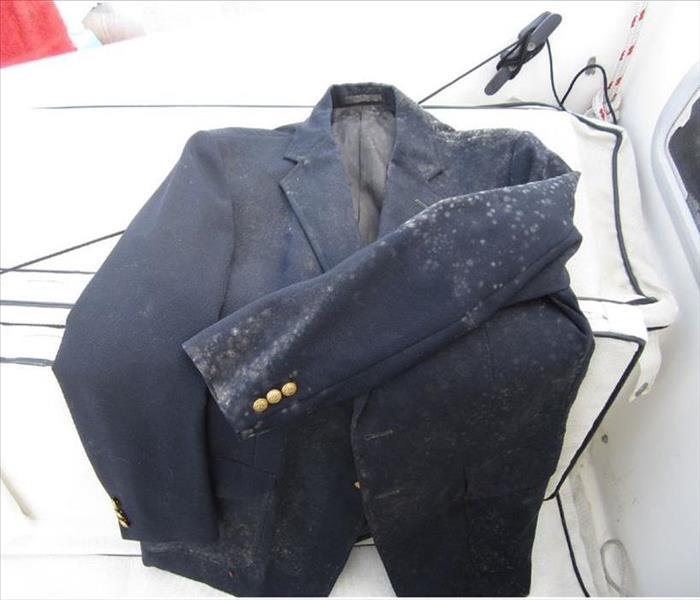 Even if you can't see any spots or growth, if the odor is present there are spores growing and treatment is necessary.
Even if you can't see any spots or growth, if the odor is present there are spores growing and treatment is necessary.
Mold can easily grow on clothes and fabric if you have too much moisture in your home. Clothes made of cotton or other organic materials make great food sources for mold and mildew to live on.
There are a few tips to keep in mind when removing mold from clothes:
- It's best to wash your clothes in hot water. Hot water kills mold more effectively than cold water and better removes mold spores and allergens too. Of course make sure you don't use water so hot that it can damage your clothing.
- When you're washing your clothes with a mold killing solution, it's best to wash them through at least two full cycles. Then after your clothes have been washed hang them on the line in the sun. The heat from the sun and the sun's ultraviolet light help to kill mold.
There are quite a few solutions you can wash moldy clothes in to get rid of the mold. Some good ones include:
- Bleach
- Borax
- Vinegar
- Baking soda
- Mold killing detergent
For the full article and a step-by-step explanation of the cleaning process, click here.
Does your home or business have mold damage? Call SERVPRO of Portage County at 800-648-1212
Does Your Home or Business Have Mold Problems?
11/9/2017 (Permalink)
If you see visible mold, do not disturb it. You can inadvertently spread the mold infestation throughout your home or business. When mold is disturbed, the mold can release microscopic mold spores which become airborne and can circulate inside your building.
What to Do:
- Stay out of affected areas.
- Turn off the HVAC system and fans.
- Contact SERVPRO of Portage County for mold remediation services.
What Not to Do:
- Don’t touch or disturb the mold.
- Don’t blow air across any surfaces with visible or suspected mold growth.
- Don’t attempt to dry the area yourself.
- Don’t spray bleach or other disinfectants on the mold.
About Our Mold Remediation Services
SERVPRO of Northern Summit County, Portage County and Canton specialize in mold cleanup and restoration, in fact, it’s a cornerstone of our business. Our crews are highly trained restoration professionals that use specialized equipment and techniques to properly remediate your mold problem quickly and safely.
If You See Signs of Mold, Call Us Today – 800-648-1212
Is It Possible to Restore Clothes that Have Been Affected by Mold?
11/9/2017 (Permalink)
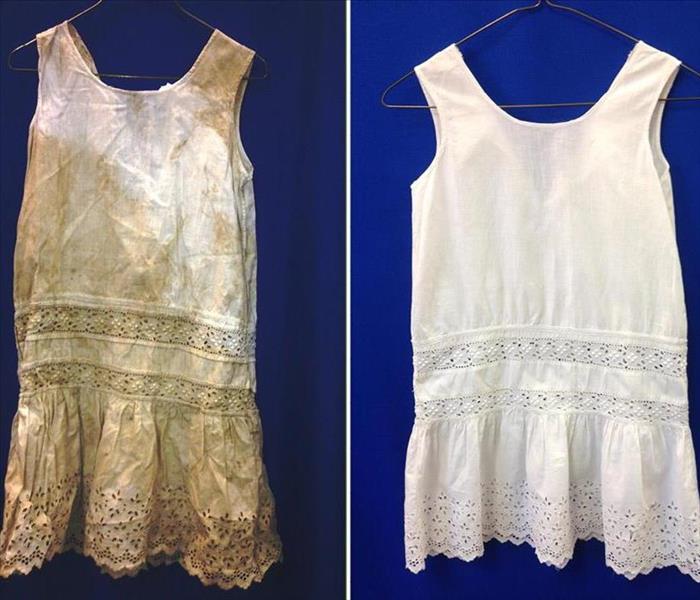 If you decide to remove mold from clothes yourself, be sure you do it safely. Refer back to our blog for more on clothing restoration.
If you decide to remove mold from clothes yourself, be sure you do it safely. Refer back to our blog for more on clothing restoration.
Any garment or fabric that has not suffered physical deterioration or discoloration as a result of mold growing on it, and that is washable (typically, a minimum of 130ºF for at least 10 minutes), can be restored completely. That goes for bacterial contamination as well, as evidenced by hospitals daily as they wash linens, gowns, surgical drapes, etc.
Dry cleaning also does a good job when evaluated and cleaned - often twice - by a qualified professional. Again, this assumes no deterioration or discoloration of the garment. Ultimately, sampling and evaluation by a qualified environmental professional can be used to confirm remediation of the garment.
Professional restoration technicians understand the need for quick response. Immediate remediation is key to controlling any escalating costs. The longer the remediation is delayed, the higher the cost of restoration. Certified restorers have the knowledge to test materials and apply the restoration techniques required to return the items to their preloss condition. Look for the IICRC logo to verify IICRC certification.
Does your home or business have mold damage? Call SERVPRO of Portage County at 800-648-1212
A Brief Guide to Mold, Moisture and Your Home
11/3/2017 (Permalink)
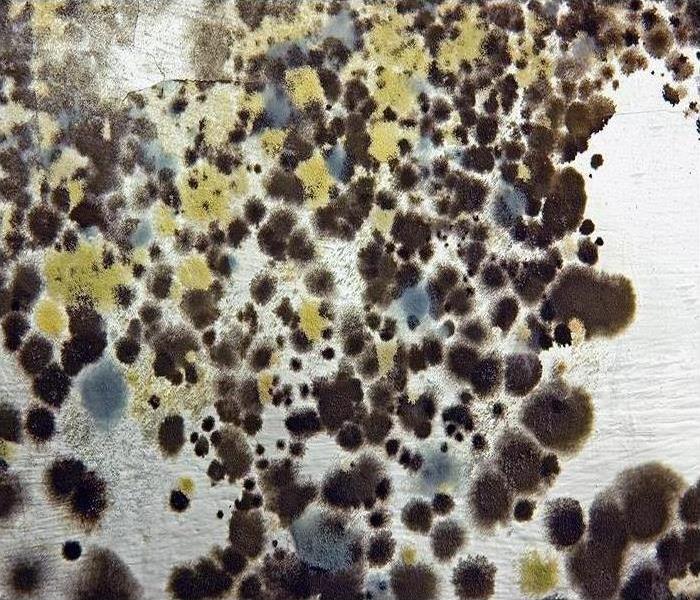 SERVPRO of Portage County can respond quickly, working to first contain the infestation and prevent its spread to other parts of the building.
SERVPRO of Portage County can respond quickly, working to first contain the infestation and prevent its spread to other parts of the building.
Provided by the U.S. Environmental Protection Agency, Office of Air and Radiation- Indoor Environments Division, this Guide provides information and guidance for homeowners and renters on how to clean up residential mold problems and how to prevent mold growth.
Contents:
- Mold Basics
- Why is mold growing in my home?
- Can mold cause health problems?
- How do I get rid of mold?
- Mold Cleanup
- Who should do the cleanup?
- Mold Cleanup Guidelines
- What to Wear When Cleaning Moldy Areas
- How Do I Know When the Remediation or Cleanup is Finished?
- Moisture and Mold Prevention and
Control Tips- Actions that will help to reduce humidity
- Actions that will help prevent condensation
- Testing or sampling for mold
- Hidden Mold
- Cleanup and Biocides
- Additional Resources
Click Here for the full PDF
Have a Mold Problem? Call SERVPRO of Portage County Today – 800-648-1212
Mold Cleanup Information for You and Your Family
10/23/2017 (Permalink)
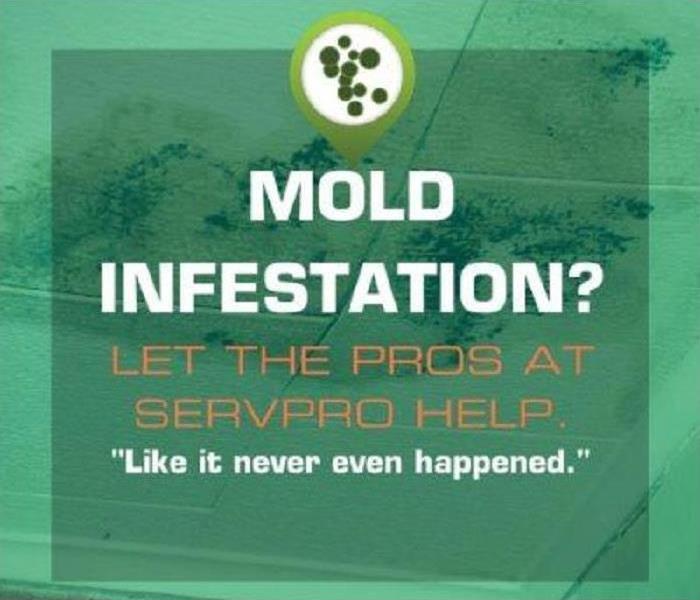 We invest in the latest equipment and ongoing mold remediation training because it helps us restore your home or business quickly and effectively.
We invest in the latest equipment and ongoing mold remediation training because it helps us restore your home or business quickly and effectively.
Molds are a natural part of the environment. They can be found anywhere there is water and moisture, so the key to controlling them in and around your home or business is moisture control. If mold is found in your home or business, you should clean up the mold promptly and fix the water problem immediately. It is also important to dry water-damaged areas and items within 24-48 hours to prevent mold growth.
Centers for Disease Control and Prevention offer resources for proper and safe mold cleanup. Click here for more information on mold cleanup information for you and your family.
Mold Damage? SERVPRO of Portage County will help- 330-677-4483
Also check out our webpage for our mold remediation process.
Follow These Tips If You Suspect Mold In Your Home or Business
9/1/2017 (Permalink)
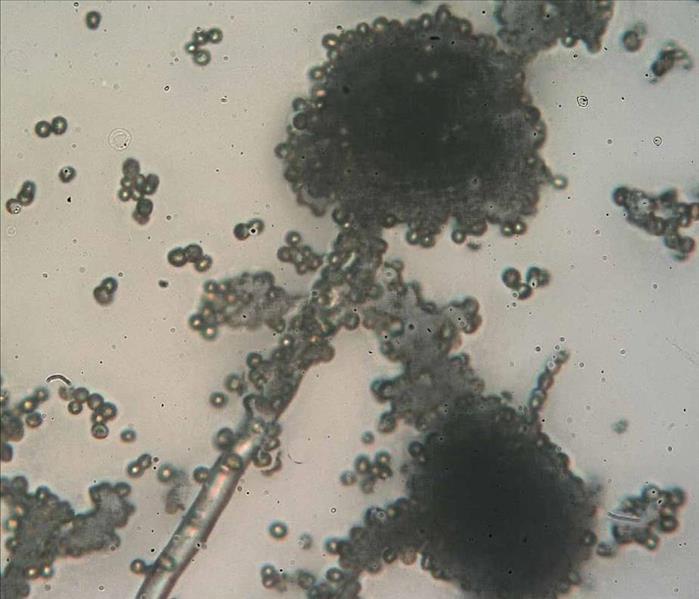 Indoors, mold needs moisture to grow; it becomes a problem only where there is water damage, elevated and prolonged humidity, or dampness.
Indoors, mold needs moisture to grow; it becomes a problem only where there is water damage, elevated and prolonged humidity, or dampness.
If you see visible mold, do not disturb it. You can inadvertently spread the mold infestation throughout your home or business. When mold is disturbed, the mold can release microscopic mold spores which become airborne and can circulate inside your building.
What to Do:
- Stay out of affected areas.
- Turn off the HVAC system and fans.
- Contact SERVPRO of Portage County for mold remediation services.
What Not to Do:
- Don’t touch or disturb the mold.
- Don’t blow air across any surfaces with visible or suspected mold growth.
- Don’t attempt to dry the area yourself.
- Don’t spray bleach or other disinfectants on the mold.
About Our Mold Remediation Services
SERVPRO of Northern Summit County, Portage County and Canton specialize in mold cleanup and restoration, in fact, it’s a cornerstone of our business. Our crews are highly trained restoration professionals that use specialized equipment and techniques to properly remediate your mold problem quickly and safely.
If You See Signs of Mold, Call Us Today – 330-677-4483
Does Your Home or Business Have Mold Problems?
9/1/2017 (Permalink)
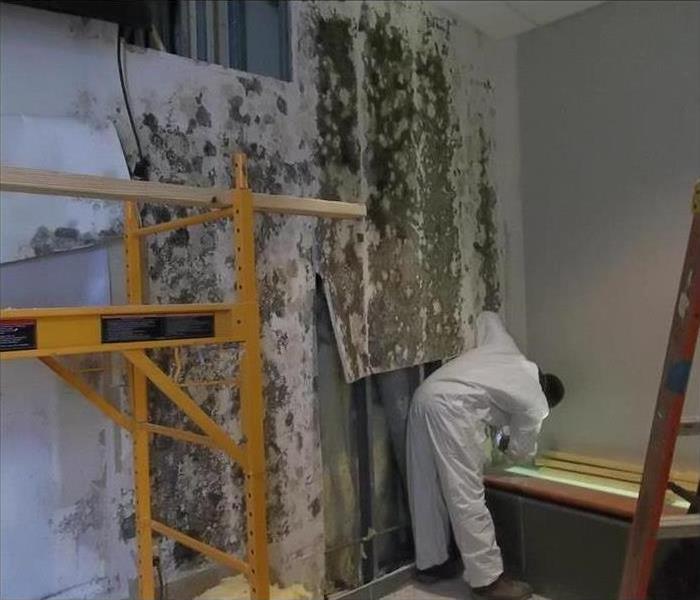 Almost all molds that grow in the built environment can produce triple helical glucan, both of which are toxic to lung cells.
Almost all molds that grow in the built environment can produce triple helical glucan, both of which are toxic to lung cells.
Microscopic mold spores naturally occur almost everywhere, both outdoors and indoors. This makes it impossible to remove all mold from a home or business. Therefore, mold remediation reduces the mold spore count back to its natural or baseline level. Some restoration businesses advertise “mold removal” and even guarantee to remove all mold, which is a fallacy. Consider the following mold facts:
- Mold is present almost everywhere, indoors and outdoors.
- Mold spores are microscopic and float along in the air and may enter your home through windows, doors, or AC/heating systems or even hitch a ride indoors on your clothing or a pet.
- Mold spores thrive on moisture. Mold spores can quickly grow into colonies when exposed to water. These colonies may produce allergens and irritants.
- Before mold remediation can begin, any sources of water or moisture must be addressed. Otherwise, the mold may return.
- Mold often produces a strong, musty odor and can lead you to possible mold problem areas.
- Even higher-than-normal indoor humidity can support mold growth. Keep indoor humidity below 45 percent.
If your home or business has a mold problem, we can inspect and assess your property and use our specialized training, equipment, and expertise to remediate your mold infestation.
5 Levels of Mold Remediation
8/28/2017 (Permalink)
 Molds destroy the material they feed on, including walls, carpets, insulation and ceilings. Unless dealt with and removed, it will continue to grow.
Molds destroy the material they feed on, including walls, carpets, insulation and ceilings. Unless dealt with and removed, it will continue to grow.
When dealing with mold contamination in your home it can be difficult to decide when a mold remediator is needed or what you can take care of yourself.
In the following 5 levels, you will have a guideline to go by when removing mold from your home:
- Level I (10 square feet or less)
Mostly found on ceilings or baseboards. Level I mold contamination may be cleaned without hiring a mold remediator, but there are several important safety precautions that you need to know: - Do not attempt cleaning mold if you suffer from asthma, allergies, or immune disorders
- Wear gloves, eye protection, and an N95 disposable respirator
- Vacate from your work area any infants less than 12 months old, individuals recovering from recent surgery, anyone with a suppressed immune system, or people with chronic lung diseases such as asthma, sever allergies, emphysema, etc.
- Contaminated materials that cannot be cleaned should be removed from your home in a sealed plastic bag to prevent an infestation in another part of your home
- Clean your work area when you’re done with a damp cloth or mop
- Make sure all areas are left dry and visibly free of mold contamination
- Level II (10-30 square feet)
About the size of one wall panel. To clean, the same precautions used in Level I should be taken. - Level III (30-100 square feet)
The size of patches of mold on several wall panels. To clean, the same precautions used in Level I and II should be taken, as well as: - Seal ventilation ducts/grills in the work area and areas directly adjacent with plastic sheeting
- Vacate everyone from your work area until work is completed.
- Level IV (greater than 100 square feet)
An infestation depending on how much greater than 100 square feet may require the assistance of a mold remediator. If not, the same requirements should be followed as were needed in levels I, II, and III along with the following: - Every worker must be trained in the handling of hazardous materials and equipped with full face respirators with high-efficiency particulate air (HEPA) cartridges, with disposable protective clothing covering both head and shoes.
- Make sure workers completely isolate their work area from the rest of your home with sheeting sealed with duct tape, including ventilation ducts/grills, fixtures, and any other openings.
- Air monitoring should be conducted prior to moving back into your home to determine if it is fit to reoccupy.
- Level V (Air Conditioners and HVAC Systems)
All remediation procedures for air conditioning units and HVAC systems should be left to professionals. Procedures for level V remediation for areas larger than 10 square feet are the same for all previous levels with the following precautionary measures added: - Shut down the HVAC system prior to remediation
- Growth-supporting materials that are contaminated, such as the paper on the insulation of interior lined ducts and filters, should be removed and sealed in plastic bags
- A variety of biocides – broad spectrum antimicrobial agents designed to prevent the growth of microorganisms – are recommended by HVAC manufacturers for use with HVAC components, such as cooling coils and condensation pans. HVAC manufacturers should be consulted for the products they recommend for use in their systems.
Do you have mold in your home or business? With questions or if you need a mold remediator, call our 24/7 Emergency Service line at (330) 677-4483. Request help online by clicking here.
Do You Need a Mold Remediator?
8/9/2017 (Permalink)
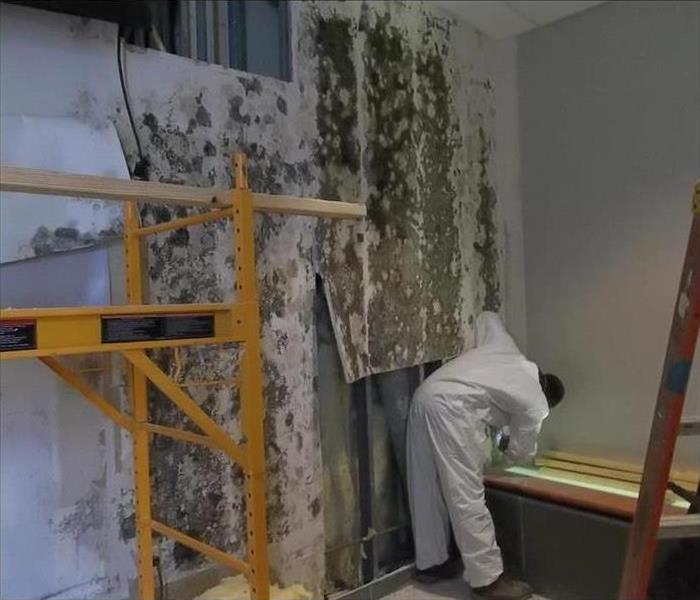 Mold spores thrive on moisture. They can quickly grow into colonies when exposed to water, producing allergens and irritants.
Mold spores thrive on moisture. They can quickly grow into colonies when exposed to water, producing allergens and irritants.
If you suspect mold in your home or business, you're probably anxious to get the problem taken care of as soon as possible. If you have small children, older adults or animals, it is even more important to effectively rid your home of mold so it doesn't affect their health.
When choosing a reliable mold remediator, it is important to consider the following tips:
- Only choose mold remediators that are certified. To ensure the highest quality of service, go with mold remediators that perform all of their own inspections and remediations. Generally, those who have been in business for a while and who have worked in a variety of settings including commercial and residential areas will be able to perform the most reliable services.
- Find a mold remediator that will inspect your home before they begin work. Later, the mold remediators should perform both an air-quality check and a swab check to test for mold. SERVPRO, among other mold remediation companies, will test for asbestos and lead as well as different types of mold. Make sure that contact information is included in the proposal so you’ll know who to get in touch with in case of problems.
- Check for a warranty. Check that the mold remediator also offers to come back and redo any area that shows signs of mold within six months to a year.
It is important to take some extra time to choose the best mold remediator to avoid further serious problems in your home or business.
If you are experiencing troubles with mold, call SERVPRO of Portage County at our 24/7 Emergency Service number, 800-648-1212 or request help online.





 24/7 Emergency Service
24/7 Emergency Service
